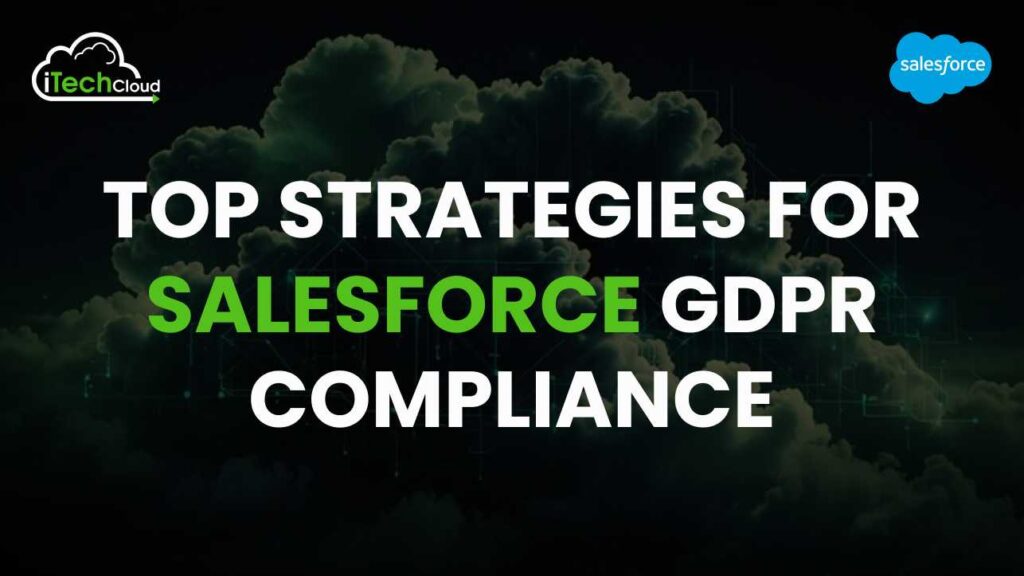Top Strategies for Salesforce GDPR Compliance

The General Data Protection Regulation (GDPR) has transformed how organizations handle personal data. As one of the most comprehensive data protection laws, it sets strict guidelines for collecting, processing, and storing personal data of EU citizens. For businesses leveraging Salesforce, achieving GDPR compliance requires a strategic approach to data management. This blog explores the top strategies to ensure your Salesforce instance aligns with GDPR requirements.
1. Data Mapping and Classification
A critical first step towards GDPR compliance is understanding what personal data your organization holds, where it is stored, and how it flows across systems. In Salesforce, this requires detailed data mapping and classification. Identify all points where personal data enters, is processed, or leaves Salesforce. Classify data based on sensitivity and retention requirements, ensuring that all personally identifiable information (PII) is properly managed.
- Data Mapping Tools: Utilize Salesforce’s native tools like Data Mask and AppExchange apps to automate data classification and mapping.
- Data Inventory: Maintain a data inventory documenting the types of personal data processed, storage locations, and data sharing practices.
2. Implement Data Minimization Principles
GDPR mandates that organizations only collect data that is necessary for a specific purpose. Implement data minimization principles within Salesforce by evaluating and refining the data collection process. This includes:
- Limiting Data Collection: Configure Salesforce forms and workflows to collect only essential data.
- Data Purging: Regularly review and delete data that is no longer needed, using tools like Salesforce Data Loader or Bulk API.
3. Strengthening Data Security Measures
Security is at the heart of GDPR compliance. Salesforce provides robust security features, but organizations must ensure they are configured and utilized correctly to protect personal data.
- Encryption: Use Salesforce Shield to encrypt sensitive data both at rest and in transit.
- Access Controls: Implement role-based access controls (RBAC) to restrict access to personal data based on user roles and responsibilities.
- Multi-Factor Authentication (MFA): Enforce MFA for all users accessing Salesforce to prevent unauthorized access.
4. Establish Clear Data Retention Policies
GDPR requires organizations to retain personal data only for as long as necessary. Establishing and enforcing data retention policies in Salesforce helps meet this requirement.
- Automated Data Retention: Salesforce automation capabilities, such as Process Builder or Flow Builder, to automate data retention and deletion processes.
- Data Archiving: Implement data archiving solutions to move old records out of active databases, ensuring that only necessary data is readily accessible.
Table of Contents
5. Consent Management
Obtaining and managing consent is a fundamental aspect of GDPR compliance. Salesforce provides tools to help manage customer consents efficiently.
- Consent Records: Track and manage consent records using Salesforce objects specifically designed for this purpose. Ensure that opt-in and opt-out preferences are captured and respected across all marketing and communication activities.
- Revoking Consent: Implement processes to allow customers to withdraw consent easily, with changes reflected in Salesforce immediately.
6. Data Subject Rights Management
GDPR compliance, individuals have rights over their personal data, including the right to access, rectify, and delete their data. Salesforce can be configured to help manage these rights efficiently.
- Data Access Requests: Implement workflows to handle data access requests promptly. Use Salesforce’s reporting tools to generate data reports for individuals requesting their data.
- Data Rectification and Erasure: Create processes to update or delete personal data as required by the individual. Ensure these changes propagate across all integrated systems.
7. Regular Data Audits and Monitoring
GDPR compliance requires regular audits and continuous monitoring. Salesforce offers several features to help organizations maintain visibility over their data practices.
- Audit Trail: Use Salesforce’s Field Audit Trail to track changes to data over time, providing a clear record of who made changes and when.
- Health Checks: Regularly perform Salesforce Health Checks to identify and remediate potential security and compliance gaps.
- Third-Party Audits: Engage third-party experts to audit your Salesforce environment, ensuring that all processes meet GDPR standards.
8. Training and Awareness Programs
GDPR compliance is not just about technology; it also involves people. Regular training and awareness programs are essential to ensure that everyone in your organization understands their role in protecting personal data.
- Salesforce Training: Provide ongoing training to Salesforce users on GDPR requirements and best practices for data handling.
- Awareness Campaigns: Run awareness campaigns focusing on the importance of data privacy and the potential consequences of non-compliance.
9. Documenting Compliance Processes
GDPR compliance requires organizations to document their compliance efforts. Within Salesforce, it’s essential to document all policies, procedures, and configurations related to GDPR.
- Compliance Documentation: Maintain detailed records of how Salesforce is configured for GDPR compliance, including data mapping, consent management, and security measures.
- Incident Response Plan: Develop and document an incident response plan that outlines the steps to be taken in the event of a data breach, including notification processes.
10. Engage with Legal and Compliance Teams
Finally, ensuring ongoing GDPR compliance Salesforce requires collaboration between your technical, legal, and compliance teams. These teams should work together to review policies, manage data subject rights, and address any legal implications of data processing.
- Regular Reviews: Schedule regular reviews with legal and compliance teams to assess the effectiveness of GDPR measures in Salesforce.
- Legal Guidance: Seek legal guidance to understand evolving GDPR requirements and how they impact your Salesforce configuration.
Conclusion: GDPR compliance Salesforce
Achieving and maintaining GDPR compliance with Salesforce requires a multifaceted approach that combines robust data management practices, strong security measures, and ongoing monitoring. By implementing the strategies outlined in this blog, organizations can build a solid foundation for GDPR compliance, protect customer data, and mitigate the risks of non-compliance. Adhering to GDPR not only ensures legal compliance but also fosters trust with customers, ultimately driving business success in a data-driven world.

